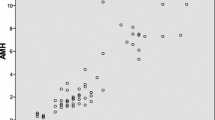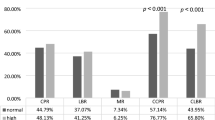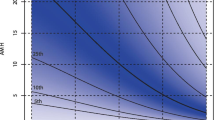Abstract
Purpose
To investigate whether serum anti-müllerian hormone (AMH), follicle stimulating hormone (FSH), or antral follicle count (AFC) are predictive for clinical pregnancy in women who underwent IVF cycles at the age of 35 and older
Methods
A total of 240 consecutive women who underwent IVF cycles at the age of 35 and older were enrolled in this crsoss- sectional study. Pregnant and nonpregnant women were compared.
Results
The median AMH level of pregnant women was higher than non-pregnant women [3.20 (0.63–9.60) vs 1.15 (0.01–14.90) ng/ml, p < 0.001]. On logistic regression analysis, AMH was an independent predictor of clinical pregnancy rate (CPR) (OR 1.353; 95 % CI 1.141–1.605; P < 0.001). After controlling for the other independent variables (the number of retrieved oocytes, AFC and age), the significant association between AMH and clinical pregnancy rate remained strong (OR 1.677; 95 % CI 1.216–2.311; p = 0.002) on multivariate logistic regression analysis.
Conclusions
AMH is an effective measure of quantitative ovarian reserve and it can predict ovarian response to controlled stimulation for advanced age women. The CPR tends to increase as AMH increases.

Similar content being viewed by others
References
Lass A, Croucher C, Duffy S, Dawson K, Margara R, Winston RM. One thousand initiated cycles of in vitro fertilization in women > or = 40 years of age. Fertil Steril. 1998;70:1030–4.
Scott RT, Toner JP, Muasher SJ, Oehninger S, Robinson S, Rosenwaks Z. Follicle-stimulating hormone levels on cycle day 3 are predictive of in vitro fertilization outcome. Fertil Steril. 1989;51:651–4.
Licciardi FL, Liu HC, Rosemwaks Z. Day 3 estradiol serum concentrations as prognosticators of ovarian stimulation response and pregnancy outcome in patients undergoing in vitro fertilization. Fertil Steril. 1995;64:991–4.
Hofmann GE, Danforth DR, Seifer DB. Inhibin-B: the physiologic basis of the clomiphene citrate challenge test for ovarian reserve screening. Fertil Steril. 1998;69:474–7.
Hendriks DJ, Mol BW, Bancsi LF, Te Velde ER, Broekmans FJ. Antral follicle count in the prediction of poor ovarian response and pregnancy after in vitro fertilization: a meta-analysis and comparison with basal follicle-stimulating hormone level. Fertil Steril. 2005;83:291–301.
Gleicher N, Weghofer A, Barad DH. Defining ovarian reserve to better understand ovarian aging. Reprod Biol Endocrinol. 2011;9:23.
Bukulmez O, Arici A. Assessment of ovarian reserve. Curr Opin Obstet Gynecol. 2004;16:231–7.
Sills ES, Alper MM, Walsh AP. Ovarian reserve screening in infertility: practical applications and theoretical directions for research. Eur J Obstet Gynecol Reprod Biol. 2009;146:30–6.
Al-Azemi M, Killick SR, Duffy S, Pye C, Refaat B, Hill N, et al. Multi-marker assessment of ovarian reserve predicts oocyte yield after ovulation induction. Hum Reprod. 2011;26:414–22.
La Marca A, Sighinolfi G, Radi D, Argento C, Baraldi E, Artenisio AC, et al. Anti-Mullerian hormone (AMH) as a predictive marker in assisted reproductive technology (ART). Hum Reprod Update. 2010;16:113–30.
Sahmay S, Cetin M, Ocal P, Kaleli S, Senol H, Birol F, et al. Serum anti-Müllerian hormone level as a predictor of poor ovarian response in vitro fertilization patients. Reprod Med Biol. 2011;10:9–14.
Lie Fong S, Visser JA, Welt CK, et al. Serum anti-Mullerian hormone levels in healthy females: a nomogram ranging from infancy to adulthood. J Clin Endocrinol Metab. 2012;97:4650–5.
Kwee J, Schats R, McDonnell J, Themmen A, de Jong F, Lambalk C. Evaluation of anti-müllerian hormone as a test for the prediction of ovarian reserve. Fertil Steril. 2008;90:737–43.
Wang JG, Douglas NC, Nakhuda GS, Choi JM, Park SJ, Thornton MH, et al. The association between anti- Müllerian hormone and IVF pregnancy outcomes is influenced by age. Reprod BioMed Onlin. 2010;21:757–61.
Elgindy EA, El-Haieg DO, El-Sebaey A. Anti-Müllerian hormone: correlation of early follicular, ovulatory and midluteal levels with ovarian response and cycle outcome in intracytoplasmic sperm injection patients. Fertil Steril. 2008;89:1670–6.
Broer SL, Mol B, Dólleman M, et al. The role of anti- Müllerian hormone assessment in assisted reproductive technology outcome. Curr Opin Obstet Gynecol. 2010;22:193–201.
Penarrubia J, Fabregues F, Manau D, Creus M, Casals G, Casamitjana R, et al. Basal and stimulation day 5 anti- Mullerian hormone serum concentrations as predictors of ovarian response and pregnancy in assisted reproductive technology cycles stimulated with gonadotropin-releasing hormone agonist-gonadotropin treatment. Hum Reprod. 2005;20:915–22.
Sahmay S, Demirayak G, Guralp O, Ocal P, Senturk LM, Oral E, et al. Serum antimüllerian hormone, follicle stimulating hormone and antral follicle count measurement cannot predict pregnancy rates in IVF/ICSI cycles. J Assist Reprod Genet. 2012;29:589–95.
Sahmay S, Guralp O, Aydogan B, Cepni I, Oral E, Irez T. Anti-Müllerian hormone and polycystic ovary syndrome: assessment of the clinical pregnancy rates in vitro fertilization patients. Gynecol Endocrinol. 2013;29(5):440–3.
Broer SL, Mol BW, Hendriks D, Broekmans FJ. The role of antimullerian hormone in prediction of outcome after IVF: comparison with the antral follicle count. Fertil Steril. 2009;91:705–14.
Smeenk JM, Sweep FC, Zielhuis GA, Kremer JA, Thomas CM, Braat DD. Antimullerian hormone predicts ovarian responsiveness, but not embryo quality or pregnancy, after in vitro fertilization or intracyoplasmic sperm injection. Fertil Steril. 2007;87:223–6.
Fridén B, Sjöblom P, Menezes J. Using anti-Müllerian hormone to identify a good prognosis group in women of advanced reproductive age. Aust N Z J Obstet Gynaecol. 2011;51(5):411–5.
Choi MH, Yoo JH, Kim HO, Cha SH, Park CW, Yang KM, et al. Serum anti-Müllerian hormone levels as a predictor of the ovarian response and IVF outcomes. Clin Exp Reprod Med. 2011;38:153–8.
Nelson SM, Yates RW, Fleming R. Serum anti-Mu¨llerian hormone and FSH: prediction of live birth and extremes of response in stimulated cycles – implications for individualization of therapy. Hum Reprod. 2007;22:2414–21.
Iliodromiti S, Kelsey TW, Wu O, Anderson RA, Nelson SM. The predictive accuracy of anti-Müllerian hormone for live birth after assisted conception: a systematic review and meta-analysis of the literature. Hum Reprod Update. 2014;20:560–70.
Al-Inany HG, Youssef MA, Aboulghar M, Broekmans F, Sterrenburg M, Smit J, Abou-Setta AM. Gonadotrophin-releasing hormone antagonists for assisted reproductive technology. Cochrane Database Syst Rev. 2011;11:(5):CD001750.
Acknowledgments
We would like to thank Hulya Senol, Naciye Erol, Burcu Dincgez Cakmak, Sukru Cebi and Mutlu Tezel for their sincere support data collection and technical assistance.
Declaration of interest
All authors have nothing to disclose. There have not been any financialsupport.
Author information
Authors and Affiliations
Corresponding author
Additional information
Capsule The AMH levels are more useful than FSH and AFC for the prediction of clinical pregnancy rate in women who underwent IVF cycles at the age of 35 and older.
Rights and permissions
About this article
Cite this article
Sahmay, S., Oncul, M., Tuten, A. et al. Anti-Müllerian hormone levels as a predictor of the pregnancy rate in women of advanced reproductive age. J Assist Reprod Genet 31, 1469–1474 (2014). https://doi.org/10.1007/s10815-014-0324-y
Received:
Accepted:
Published:
Issue Date:
DOI: https://doi.org/10.1007/s10815-014-0324-y




